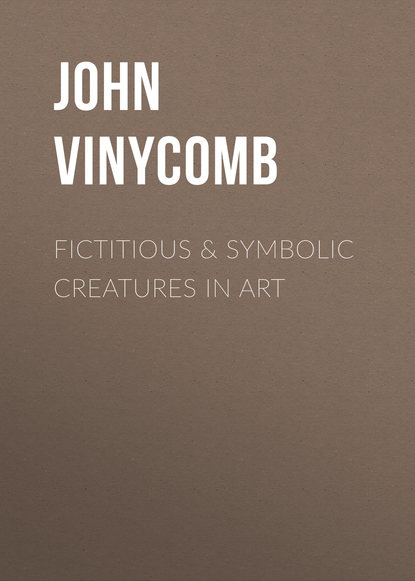 Полная версия
Полная версияFictitious & Symbolic Creatures in Art
A statue of the Theban sphynx found in Colchester, and now in the museum of that town, gives the Greek conception of that creature. It is carved in oolite, twenty-five inches high, evidently a relic of the Roman occupation of Britain. It represents the monster seated over the mangled remains of one of its victims. Llewellin Jewett, in the Art Journal 1871, p. 113, describes it as “combining the five-fold attributes of a virgin, a lion, a bird, a dog, and a serpent. The head, breast and arms are those of a beautiful virgin; the body and teats of a female dog; hinder parts, hind legs and fore paws are those of a lioness; the tail doubled in short folds is serpent, and the wings those of a bird.”
The same writer says: “The sphynx appears on the reverses of some coins of Cunobeline (Cymbeline, of Shakespeare), struck in the city of Camalodunum (Colchester).”
The gigantic statue of the sphynx half buried in the sand near the Great Pyramids, at Gizeh, is hewn and sculptured out of a spur of solid rock, to which masonry was added in places to complete the form. The actual age of the great sphynx is not known, but it is supposed to have been commenced under Cheops and finished by order of King Chefren, under whose reign also was probably built the second great pyramid. The able author of “Eothen” thus describes the appearance of the sphynx of Egypt, and the sentiments to which its contemplation gave rise in his mind: “And near the Pyramids, more numerous and more awful than all else in the land of Egypt, there rests the lonely sphynx. Comely the creature is, but the comeliness is not of this world. The once worshipped beast is a deformity and a monster to this generation, and yet you can see that these lips, so thick and heavy, were fashioned according to some ancient mould of beauty—some mould of beauty now forgotten—forgotten because that Greece drew forth Cytheræa from the flashing bosom of the Ægean, and in her image created new forms of beauty, and made it a law among men that the short and proudly wreathed lips should stand for the sign and main condition of loveliness through all generations to come! Yet there still lives on the race of those who were beautiful in the fashion of the elder world; and Christian girls of Coptic blood will look on you with sad, curious gaze, and kiss your charitable hand with the big pouting lips of the very sphynx. Laugh and mock if you will at the worship of stone idols; but mark ye this, ye breakers of images, that in one regard the stone idol bears awful semblance of deity—unchangefulness in the midst of change—the same seeming will and intent for ever inexorable! Upon ancient dynasties of Ethiopian and Egyptian kings—upon Greek and Roman, upon Arab and Ottoman conquerors—upon Napoleon dreaming of an Eastern empire—upon battle and pestilence—upon the ceaseless misery of the Egyptian race—upon keen-eyed travellers—Herodotus yesterday and Warburton to-day—upon all, and more, this unworldly sphynx has watched, and watched like a Providence, with the same earnest eyes and the same sad, tranquil mien. And we shall die, and Islam shall wither away; and the Englishman, straining far over to hold his loved India, will plant a firm foot on the banks of the Nile, and sit on the seats of the faithful; and still that sleepless rock will lie watching and earnest the work of the new busy race with those same sad eyes and the same tranquil mien everlasting. You dare not mock at the sphynx.” The conclusion of this rhapsody at the present time sounds almost like a half-fulfilled prophecy.
The sphynx is the special device of several British regiments which landed in Egypt, in the Bay of Aboukir, in the face of the French Army; and borne as a memento of the battle of Alexandria, when General Sir Ralph Abercrombie fell in the moment of victory. It also appears upon the war medals of the English occupation of Egypt, resulting in the battle of Tel-el-Kebir, 1882, and subsequent victories. In heraldry the sphynx is usually couchant; it is, however, borne in other positions, sometimes winged, and when so borne the wings are always endorsed, i.e., back to back.
A sphynx passant, wings endorsed argent crined or, is the crest of Asgill (Bart. 1701).
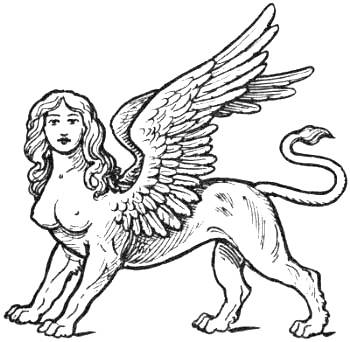
A Sphynx passant guardant, wings endorsed.
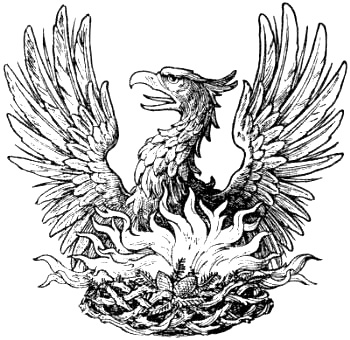
The Phœnix.
The Phœnix Bird of the Sun
“Rara avis in terris.”
An imaginary bird, described by ancient writers as in form like an eagle, but more beautiful in its plumage. Among the ancient classical writers it was an emblem of those existing in paradise, enjoying eternal youth and never-ending pleasure. Tacitus describes the phœnix as a singular bird, consecrated to the sun, and distinguished by its rich appearance and variegated colours. Herodotus naïvely says: “I never saw one, indeed, but in a picture, but if he is like his picture his plumage is partly golden and partly red.” Philippe de Thaun says: “The phœnix lives five hundred years and a little more, when it will become young again and leave its old age.” It was said to be sometimes seen in Egypt, and only one was believed to exist at a time. When it is advanced in age and its time of change is at hand, it hides itself away somewhere in Arabia, and makes itself a nest of the rarest spices, which, by the heat of the sun or other secret agency, and the fanning of the sacred bird’s own wings, soon rises into flames and consumes it. Out of its ashes rises another with new life and vigour to pursue the same never-ending life and re-birth.
Fum or Fung (the phœnix) is one of the four symbolical animals supposed to preside over the destinies of the Chinese Empire; the sacred Ho-ho or phœnix also figures with the dragon largely in Japanese mythology, and bears a striking analogy to the bird of classic fame. It is fabled to have a miraculous existence, and is sent on earth for the performance of extraordinary works in the manifestation of the Divinity and in the development of humanity and nature. It appears at different stages of the world’s progress and in successive ages; after the accomplishment of which it reascends to heaven to come down again at the commencement of a new era.
From the pagans the Early Christians adopted the symbol, and with them its significance had reference to the resurrection and immortality. Like the pelican “in her piety,” it was peculiarly an emblem of our Saviour in His resurrection. As the phœnix when old and wearied seeks the rays of the sun to consume its body, again to be revived in life and vigour, so the Christian, worn and exhausted by worldly labour and suffering, turns to the Son of Righteousness for regeneration and newness of life. Tertullian makes the phœnix an image of the resurrection.
In corroboration of this it must be borne in mind that Jesus Christ, who died a.d. 34, is termed the phœnix by monastic writers.
The Phœnix period or cycle is said to consist of 300 years. “The bird of wonder” is said to have appeared in Egypt five times:
1. In the reign of Sesostris, b.c. 866.
2. In the reign of Amasis, b.c. 566.
3. In the reign of Ptolemy Philadelphus, b.c. 266.
4. In the reign of Tiberius, 34 a.d.
5. In the reign of Constantine, 334 a.d.
Tacitus in the “Annales,” vi. 28, mentions the first three of these appearances.
The Phœnix-tree is the palm. In Greek φοίνιξ (phoinix) means both phœnix and palm-tree. It is thus alluded to in Shakespeare:
“Now will I believe … that in ArabiaThere is one tree, the phœnix throne—one phœnixAt this hour reigneth there.” The Tempest, Act iii. sc. 3.Pliny20 gives minute particulars concerning the natural history of this rara avis in terris. But the ancient fable is most fully given by Ovid and translated by Dryden. Ariosto, also, and many early writers refer to the wonderful creature with fullest faith in its reality. It is no wonder then, that it became a favourite emblem in an age when it was the fashion among persons of distinction to have an impress or device with its accompanying legend or motto. Many persons of historical importance employed the phœnix to express in metaphor the idea they wished to convey regarding themselves. Thus we find the phœnix in flames painted for the device of Jeanne d’Arc, in the Gallery of the Palais Royal, with the motto: “Invito funere vivat” (“Her death itself will make her live”).
Vittoria Colonna (+ 1547) the beautiful and accomplished wife of the Marquis of Pescara, used the device of a phœnix on her medal.
Mary Queen of Scots used the impress of her mother, Mary of Lorraine, a phœnix in flames, and the motto: “En ma fin est mon commencement.” A phœnix in flames upon a castle was the badge of Queen Jane Seymour, the crest of the Seymours being a phœnix in flames issuing from a ducal coronet. Her son, Edward VI., added the motto, “Nascatur ut alter” (“That another may be born”), alluding to the nature of her death. She lies buried in St. George’s Chapel, Windsor, with a Latin epitaph by Bishop Godwin, which has been thus translated by his son Morgan:
“Here a phœnix lieth, whose deathTo another phœnix gave birth.It is to be lamented muchThe world at once ne’er knew two such.”Queen Elizabeth placed a phœnix upon her medals and tokens with her favourite motto: “Semper eadem” (“Always the same”), and sometimes with the motto “Sola phœnix omnis mundi” (“The sole phœnix of the whole world”); and on the other side, “Et Angliæ gloria” (“And the glory of England”), with her portrait full-faced. By the poets of the time, Elizabeth was often compared to the phœnix. Sylvester, in his “Corona Dedicatoria,” says:
“As when the Arabian (only) bird doth burneHer aged bodie in sweet flames to death,Out of her cinders a new bird hath birth,On whom the beauties of the first return;From spicy ashes of the sacred urneOf our dead phœnix (deare Elizabeth)A new true phœnix lively flourisheth.”And Shakespeare, in the prophecy which he puts into the mouth of Cranmer at the baptism of the Princess Elizabeth, her great and glorious reign is foreshadowed, and finally:
“… as whenThe bird of wonder dies, the maiden phœnix,Her ashes new create another heir,As great in admiration as herself.”Shakespeare elsewhere uses the simile to denote a phœnix among women—a phœnix, a paragon, unique, because alone of its kind:
“If she be furnished with a mind so rare,She is alone the Arabian bird.” Cymbeline, Act i. sc. 7.Many other heraldic mottoes have been associated with this celebrated device. The following are from “Historic Devices, Badges,” &c., by Mrs. Bury Palliser:
Eleanor, Queen of Francis I. of Austria: “Non est similis illi” (“There is none like her”). She afterwards changed her motto, either showing how much she was neglected, or to express her determination to remain single: “Unica semper avis” (“Always a solitary bird”).
Bona of Savoy: “Sola facta solum deum sequor.”
Cardinal Trent: “Ut vivat” (“That it may live”).
Linacre: “Vivat post funera virtus” (“Virtue survives death”).
“De mi muerte ma vida” (“From my death my life”).
“De mort à vie” (“From death to life”).
“Et morte vitam protulit” (“And by death has prolonged his life”).
“Ex morte, immortalitas” (“Out of death, immortality”).
“Murio y nacio” (“I die and am born”).
“Ne pereat” (“That it should not perish”).
“O mors, ero mors tua” (“O death, I shall be thy death”).
“Se necat ut vivat” (“Slays himself that he may live”).
“Trouva sol nei tormenti il suo gioire” (“It finds alone its joy in its suffering”).
“Vivre pour mourir, mourir pour vivre” (“Live to die, die to live”).
“Uror, morior, orior” (“I am burnt, I die, I arise”).
The phœnix in heraldry is never represented in other than in one position, rising from flames, that is, with expanded wings and enveloped in flames of fire in which it is being consumed. It is usually represented exactly as an eagle in shape, but may be of any of the heraldic tinctures.
The phœnix is of frequent use in heraldry, and borne by many families in the United Kingdom. A phœnix issuing from a ducal coronet is the crest of the Duke of Somerset.
Linacre, founder of the College of Physicians, and honorary physician to four sovereigns has on his tomb in Westminster Abbey the device of the phœnix, with the motto, “Vivat post funera virtus” (“Virtue survives death”).
From the association of this fabulous bird with alchemy, Paracelsus wrote concerning it, and several alchemists employed it to symbolise their vocation. It was adopted by the Apothecaries’ Company as crest, and is a frequent sign over chemists’ shops.
A phœnix in flames proper, gorged with a mural coronet, is the allusive crest of the Fenwicks; the motto over the crest is the cri de guerre, “A Fenwick! a Fenwick!” They were a family noted in border warfare. “The house of Percy,” says Mrs. Bury Palliser, “ever ranked the Fenwicks among the most valiant of its retainers, and in border warfare the banner of the gorged phœnix in the burning flame always appeared with that of the silver crescent of the Percys.”
The bird of paradise is interesting as having for a time been accepted as the veritable phœnix, a fact which has escaped Gibbon. That luxurious Emperor, Heliogabalus, having eaten, as he thought, of every known delicacy, bethought him one day of the fabled phœnix. What mattered it that only one bird existed at a time; that one, the imperial gourmand must have, and was inconsolable that he had not thought of it before. The zeal of proconsuls was equal to the great occasion, and from all parts of the earth came strange and wondrous birds, each affirmed with confidence to be “the sacred solitary bird, that knows no second, knows no third.” The cankerworm of doubt remains! At last, one day there was brought to Rome from the far islands of the Eastern seas a bird, the like of which for the glory of its plumage had never been seen out of paradise, the veritable phœnix, “Bird of the Sun!” The sight of the magnificent creature carried conviction with it. Heliogabalus ate in faith, and went to his fathers contented.
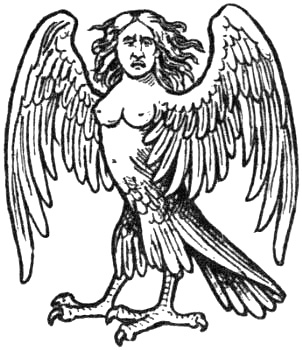
A Harpy, wings disclosed.
The Harpy
“Of monsters all, most monstrous this; no greater wrathGod sends ’mongst men; it comes from depth of pitchy hell:And virgin’s face, but womb like gulf unsatiate hath,Her hands are griping claws, her colour pale and fell.”Virgil.“Thou art like the harpy,Which to betray, doth wear an angel’s face,Seize with an eagle’s talons.”“Pericles Prince of Tyre,” Act iv. sc. 4.A poetical monstrosity of classical origin, described as “winged creatures having the head and breasts of a woman, and the body and limbs of a vulture; very fierce and loathsome, living in an atmosphere of filth and stench, and contaminating anything which they come near. Pale and emaciated, they were continually tormented with insatiable hunger.” They are best known from the story of the Argonauts, where they appear as the tormentors of the blind king Phineus, whose table they robbed of its viands, which they either devoured or spoiled. They were regarded by the ancients as ministers of sudden death.
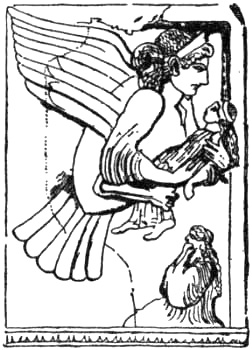
The Harpy, Greek sculpture.
In Miss Millington’s admirable book, “Heraldry in History, Poetry and Romance,” it is stated that unlike the generality of such mythical beings, the harpies appear originally, as in Homer’s “Odyssey,” as persons instead of personations; while later authors for the most part reduced them to whirlwinds and whirlpools. Homer mentions but one harpy. Hesiod gives two, later writers three. The names indicate that these monsters were impersonations of whirlwinds and storms. The names were: Ocypeta (rapid), Celeno (blackness), Aello (storm).
“I will … do any embassage … rather thanHold three words’ conference with this harpy.” Much Ado About Nothing, Act ii. sc. 1.“Bravely the figure of this harpy hast thouPerformed, my Ariel; a grace it had devouring.” Tempest, Act iii. sc. 3.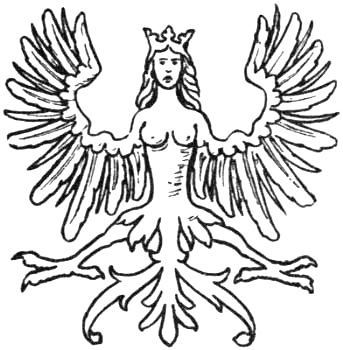
A Harpy displayed and crowned. German version.
Azure, a harpy with her wings disclosed, her hair flotant, or, armed of the same. This coat existed in Huntingdon Church in Guillam’s time.
The arms of the City of Nuremberg are: azure, a harpy displayed armed, crined and crowned, or. It occurs as the city device as early as 1243. In German heraldry it is termed jungfraundler.
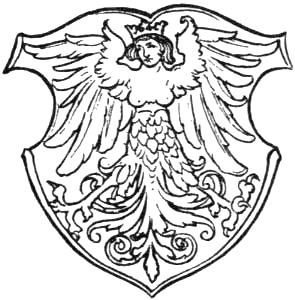
Shield of Nüremberg.
A creature very similar to the harpy (a combination of several badges), was one of the favourite devices of Richard III., viz., a falcon with the head of a maiden holding the white rose of York.
The Heraldic Pelican
“Then sayd the pellycaneWhen my byrats be slayneWith my bloude I them reuyue (revive)Scrypture doth record,The same dyd our Lord,And rose from deth to lyue.”Skelton, “Armory of Birds.”The character ascribed to the pelican is nearly as fabulous as that of the phœnix. From a clumsy, gluttonous, piscivorous water-bird, it was by the growth of legends transformed into a mystic emblem of Christ, whom Dante terms “Nostro Pelicano.” St. Hieronymus gives the story of the pelican restoring its young ones destroyed by serpents as an illustration of the destruction of man by the old Serpent, and his salvation by the blood of Christ.
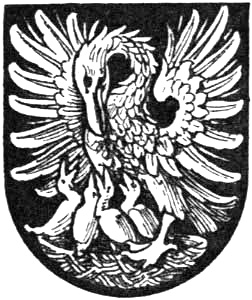
A Pelican in her piety, wings displayed.
The Pelican in Christian Art is an emblem of Jesus Christ, by “whose blood we are healed.” It is also a symbol of charity.
The “Bestiarum” says that Physiologus tells us that the pelican is very fond of its brood, but when the young ones begin to grow they rebel against the male bird and provoke his anger, so that he kills them; the mother returns to the nest in three days, sits on the dead birds, pours her blood over them, and they feed on the blood.
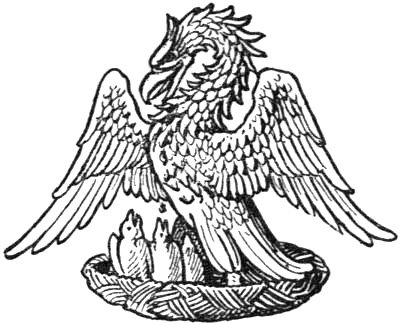
Heraldic Pelican in her piety.
Heralds usually represent this bird with wings endorsed and neck embowed, wounding her breast with her beak. Very many early painters mistakenly represented it similar to an eagle, and not as a natural pelican, which has an enormous bag attached to the lower mandible, and extending almost from the point of the bill to the throat. When in her nest feeding her young with her blood, she is said to be in her piety.
The Romans called filial love piety, hence Virgil’s hero is called the “pious Æneas,” because he rescued his father from the flames of Troy.
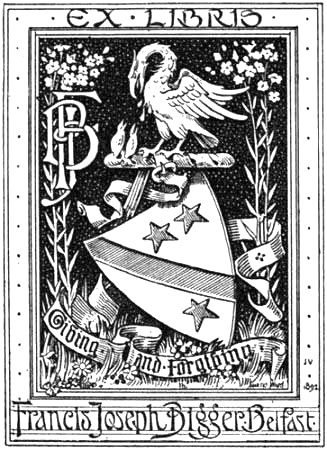
Crest, a Pelican vulning herself proper, wings endorsed.
The myth that pelicans feed their young with their blood arose from the following habit, on which the whole superstructure of fable has been erected: They have a large bag attached to their under-bill. When the parent bird is about to feed its brood, it macerates small fish in this bag or pouch; then, pressing the bag against its breast, transfers the macerated food to the mouths of the young ones.
The pelican in her piety is not an uncommon symbol upon monumental brasses. That of William Prestwick, Dean of Hastings, in Warbleton Church, Sussex, has it with the explanatory motto: “Sic Xtus dilexit nos.”
Examples.—Gules, a pelican in her piety, or.—Chauntrell.
Azure, three pelicans argent, vulning themselves proper.—Pelham, Somerset, &c.
A pelican’s head erased, or otherwise detached from the body, must always be drawn in the same position and vulning itself. It should always be separated as low as the upper part of the breast.
It is said naturalists of old, observing that the pelican had a crimson stain on the tip of its beak, reported that it was accustomed to feed its young with the blood flowing from its breast, which it tore for the purpose. In this belief the Early Christians adopted the pelican to figure Christ, and set forth the redemption through His blood, which was willingly shed for us His children.
Alphonso the Wise, King of Castile (+ 1252). A pelican in its piety. Motto: “Pro lege et grege.”
William of Nassau, founder of the Republic of the United Provinces, one of the noblest characters of modern history. He bore on some of his standards the pelican, and on others the motto: “Pro lege, grege et rege.”
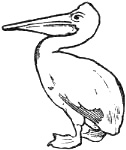
The natural Pelican.
Pope Clement IX. One of his devices was the pelican in its piety. Motto: “Aliis non sibi clemens” (“Tender-hearted to others, not himself”).
Other mottoes for the pelican:
“Ut vitam habeant” (“That they may have life”).
“Immemor ipse sui” (“Unmindful herself of herself”).
“Mortuos vivificat” (“Makes the dead live”).
“Nec sibi parcit” (“Nor spares herself”).
The Martlet
“The guest of summer,The temple-haunting martlet.”“Macbeth.”
The Martlet (Merlette or Merlot, French; Merula, Latin). The house-marten or swallow is a favourite device in heraldry all over Europe, and has assumed a somewhat unreal character from the circumstance that it catches its food on the wing and never appears to alight on the ground as other birds do. It builds its nest frequently under the eaves of houses, from whence it can take flight readily, rarely alighting, as it gains its food while on the wing; the length of its wings and the shortness of its legs preventing it from rising should it rest on the ground.
“No jutty friese,Buttress, nor coign of vantage, but this birdHath made his pendant bed, and procreant cradle.” Macbeth, Act i. sc. 6.It is depicted in armory with wings close, and in profile, with thighs, but with no visible legs or feet.
The martlet is the appropriate “difference” or mark of cadency for the fourth son. Sylvanus Morgan says: “It modernly used to signify, as that bird seldom lights on land, so younger brothers have little land to rest on but the wings of their own endeavours, who, like the swallows, become the travellers in their seasons.”
The swallow (hirondelle) is the punning cognisance for Arundell. The seal of the town of Arundel is a swallow, Baron Arundell of Wardour bears six swallows for his arms. The great Arundells have as motto, “De Hirundine” (“Concerning the swallow”), and “Nulli præda” (“A prey to none”). A Latin poem of the twelfth century is thus rendered:
“Swift as the swallow, whence his arms’ deviceAnd his own arms are took, enraged he fliesThro’ gazing troops, the wonder of the field,And strikes his lance in William’s glittering shield.”“We find it in Glovers’ roll,” says Planché, “borne by Roger de Merley, clearly as ‘armes parlantes,’ although in a border.” Roger de Merley: “barée d’argent et de goulz à la bordure d’azur, et merlots d’or en le bordure”; showing it was some difference of a family coat.
The Alerion
is a heraldic bird, represented as an eaglet displayed, but without beak or claws. Some writers confound it with the martlet, stating that the alerion is the same bird with its wings displayed or extended. They are first found in the arms of Lorraine, which are blazoned or, on a bend gules, three Alerions argent, and are said to be assumed in commemoration of an extraordinary shot made by Godfrey de Boulogne, “who at one draught of his bow, shooting against David’s Tower in Jerusalem, broched three feetless birds called Alerions, which the House of Lorraine, decending from his race, continued to this day.” It is impossible, says Planché, who broached this wonderful story, but it is perfectly evident that the narrator was the party who drew the longbow, and not the noble Godfrey.



